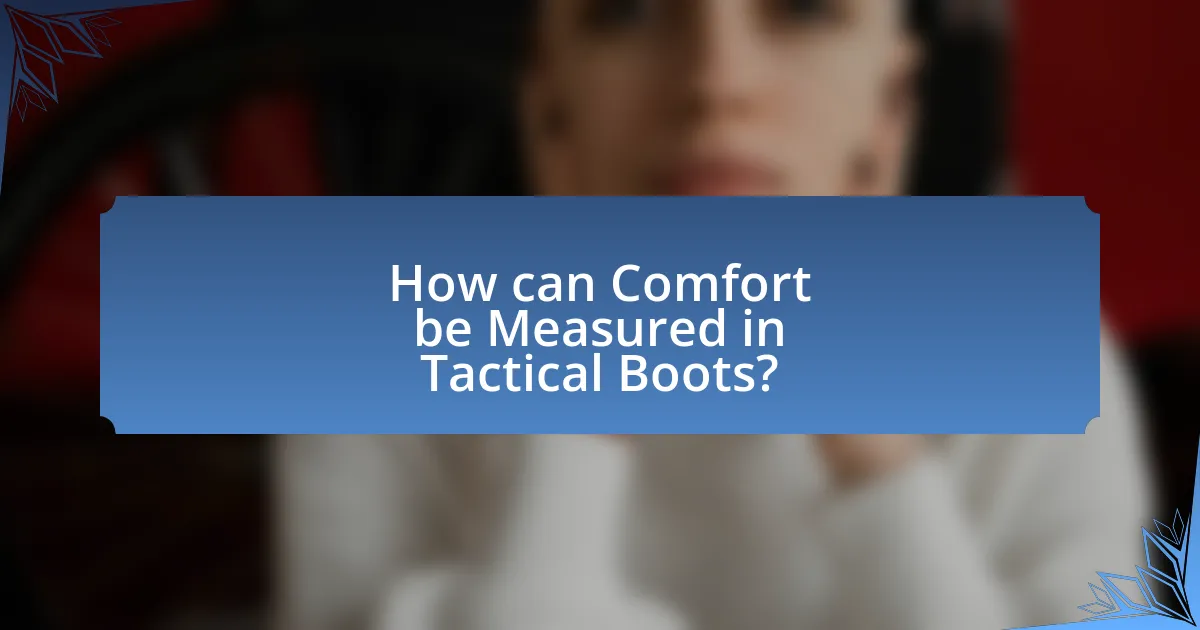Tactical boots are specialized footwear designed for military, law enforcement, and outdoor activities, prioritizing durability, support, and protection. This article evaluates the essential features that distinguish tactical boots from regular footwear, including material quality, comfort, durability, traction, and waterproofing. It explores the significance of design elements such as cushioning, fit, and ankle support in enhancing performance and preventing injuries. Additionally, the article discusses various types of tactical boots, maintenance practices, and top recommendations for high-quality options that excel in comfort and durability, providing a comprehensive guide for users seeking reliable footwear for demanding environments.

What are Tactical Boots and Why are They Important?
Tactical boots are specialized footwear designed for military, law enforcement, and outdoor activities, emphasizing durability, support, and protection. These boots are important because they provide essential features such as slip resistance, waterproofing, and ankle support, which enhance safety and performance in challenging environments. For instance, a study by the U.S. Army Research Institute of Environmental Medicine highlights that proper footwear significantly reduces the risk of injuries during strenuous activities.
How do Tactical Boots differ from Regular Footwear?
Tactical boots differ from regular footwear primarily in their design and functionality, specifically tailored for demanding environments. Tactical boots are constructed with durable materials, often featuring reinforced toe caps, waterproofing, and slip-resistant soles, which enhance protection and performance in rugged conditions. In contrast, regular footwear typically prioritizes comfort and style over specialized features, lacking the robust construction and support necessary for tactical applications. For example, tactical boots often include features like ankle support and puncture-resistant soles, which are essential for military, law enforcement, and outdoor activities, whereas regular shoes may not provide such protective elements.
What features make Tactical Boots suitable for demanding environments?
Tactical boots are suitable for demanding environments due to their durability, traction, waterproofing, and support features. The robust materials used in their construction, such as leather and synthetic fabrics, provide resistance to wear and tear, essential for harsh conditions. Additionally, specialized outsoles with deep treads enhance grip on various surfaces, ensuring stability and safety. Waterproof membranes keep feet dry in wet conditions, while cushioned insoles and ankle support reduce fatigue and prevent injuries during prolonged use. These features collectively ensure that tactical boots can withstand the rigors of challenging environments effectively.
Why is material choice crucial in Tactical Boot design?
Material choice is crucial in tactical boot design because it directly impacts performance, durability, and comfort. The selection of materials such as leather, nylon, or synthetic composites determines the boot’s weight, breathability, waterproofing, and resistance to abrasion. For instance, high-quality leather offers durability and water resistance, while lightweight synthetic materials enhance agility and comfort during prolonged wear. Research indicates that boots made from advanced materials can reduce fatigue and improve overall foot health, which is essential for tactical operations that require extended periods of movement. Therefore, the right material not only enhances functionality but also ensures the safety and effectiveness of the wearer in demanding environments.
What are the key factors to consider when evaluating Tactical Boots?
When evaluating tactical boots, key factors include material quality, comfort, durability, traction, and waterproofing. Material quality affects the boot’s longevity and performance; for instance, leather and synthetic materials offer different benefits in terms of breathability and weight. Comfort is crucial, as boots should provide adequate support and cushioning for extended wear, which can be assessed through features like padded collars and insoles. Durability is essential for withstanding harsh conditions, often indicated by the construction methods and materials used. Traction is vital for stability on various terrains, typically evaluated through the outsole design and rubber composition. Lastly, waterproofing is important for maintaining dryness in wet environments, often achieved through specialized membranes or treatments.
How does comfort impact the performance of Tactical Boots?
Comfort significantly enhances the performance of tactical boots by reducing fatigue and improving mobility. When tactical boots are designed with comfort in mind, they allow for prolonged wear without causing discomfort, which is crucial for users who may be on their feet for extended periods. Studies indicate that comfortable footwear can lead to better posture and alignment, which directly affects agility and endurance during physical activities. For instance, a study published in the Journal of Foot and Ankle Research found that well-cushioned and supportive footwear can decrease the risk of injuries and enhance overall performance in demanding environments. Thus, the integration of comfort features in tactical boots is essential for optimal functionality and effectiveness in the field.
What role does durability play in the selection of Tactical Boots?
Durability is a critical factor in the selection of tactical boots, as it directly impacts their performance and longevity in demanding environments. Tactical boots are often subjected to harsh conditions, including rough terrains and extreme weather, making durable materials essential for maintaining structural integrity and functionality. For instance, boots made from high-quality leather or synthetic materials can withstand wear and tear, ensuring that they remain reliable over time. Additionally, studies have shown that durable footwear can reduce the risk of injuries, as they provide better support and protection, which is vital for military personnel and first responders who rely on their gear in high-stakes situations.
What are the common types of Tactical Boots available?
Common types of tactical boots available include combat boots, desert boots, waterproof boots, and lightweight tactical boots. Combat boots are designed for durability and support in various terrains, often featuring reinforced toes and ankle support. Desert boots are lightweight and breathable, suitable for hot climates, typically made from suede or canvas. Waterproof boots are constructed with materials that prevent water penetration, ideal for wet conditions. Lightweight tactical boots prioritize agility and comfort, often incorporating advanced materials for reduced weight while maintaining support. These classifications are based on their specific features and intended use, ensuring they meet the demands of military, law enforcement, and outdoor activities.
What are the differences between waterproof and non-waterproof Tactical Boots?
Waterproof tactical boots are designed to prevent water from entering, utilizing materials like Gore-Tex or rubber membranes, while non-waterproof tactical boots lack these features, allowing moisture to penetrate. The waterproof variants are ideal for wet environments, ensuring feet remain dry and comfortable, which is crucial for prolonged use in adverse conditions. In contrast, non-waterproof boots are typically more breathable and lighter, making them suitable for dry climates or situations where water exposure is minimal. The choice between the two depends on the specific operational environment and user needs, as waterproof boots provide protection against water but may sacrifice some breathability compared to their non-waterproof counterparts.
How do lightweight Tactical Boots compare to heavier models?
Lightweight tactical boots are generally more comfortable and provide greater agility compared to heavier models. The reduced weight allows for easier movement, which is crucial in tactical situations where speed and responsiveness are essential. Additionally, lightweight boots often feature advanced materials that enhance breathability and moisture-wicking properties, contributing to overall comfort during extended wear. In contrast, heavier models may offer increased durability and protection, often incorporating thicker materials and reinforced structures, which can be beneficial in rugged environments. However, this added weight can lead to fatigue over time, especially during prolonged use. Studies indicate that footwear weight significantly impacts performance, with lighter options often resulting in improved endurance and reduced strain on the body.

How can Comfort be Measured in Tactical Boots?
Comfort in tactical boots can be measured through several key factors, including fit, cushioning, breathability, and weight. Fit is assessed by ensuring the boot accommodates the foot shape without causing pressure points, which can be evaluated through sizing charts and user feedback. Cushioning is measured by the type and thickness of insoles and midsoles, with materials like EVA foam providing better shock absorption. Breathability is determined by the materials used in the upper construction, such as mesh or waterproof membranes, which affect moisture management. Weight is also a critical factor, as lighter boots generally enhance comfort during prolonged wear. Studies indicate that boots with optimal cushioning and fit can reduce fatigue and discomfort, supporting the importance of these measurements in evaluating comfort.
What specific features contribute to the comfort of Tactical Boots?
Tactical boots are designed with specific features that enhance comfort, including cushioned insoles, moisture-wicking linings, and supportive midsoles. Cushioned insoles provide shock absorption, reducing fatigue during prolonged wear. Moisture-wicking linings help keep feet dry, preventing discomfort caused by sweat. Supportive midsoles offer stability and arch support, which is crucial for maintaining comfort during extended activities. Additionally, features like padded collars and breathable materials further contribute to overall comfort by reducing pressure points and allowing airflow. These elements collectively ensure that tactical boots can be worn comfortably for long periods, making them suitable for demanding environments.
How does cushioning technology enhance comfort in Tactical Boots?
Cushioning technology enhances comfort in tactical boots by providing shock absorption and reducing impact on the feet during movement. This technology often incorporates materials such as EVA foam or gel inserts, which conform to the foot’s shape, offering personalized support. Studies indicate that effective cushioning can decrease fatigue and discomfort, allowing for prolonged wear without pain. For example, research published in the Journal of Foot and Ankle Research highlights that boots with advanced cushioning systems significantly improve comfort levels compared to traditional designs, thereby validating the importance of cushioning in tactical footwear.
What is the significance of fit and sizing in ensuring comfort?
Fit and sizing are crucial in ensuring comfort because they directly affect how well footwear conforms to the foot’s shape and movement. Proper fit minimizes pressure points and friction, which can lead to discomfort or injury during prolonged wear. Studies indicate that ill-fitting shoes can cause issues such as blisters, calluses, and foot fatigue, highlighting the importance of accurate sizing. For example, a survey by the American Podiatric Medical Association found that 72% of participants experienced foot pain due to improper shoe fit. Therefore, selecting tactical boots with the right fit and sizing is essential for maintaining comfort and preventing foot-related problems during use.
How does the design of Tactical Boots affect comfort?
The design of tactical boots significantly affects comfort through features such as cushioning, arch support, and breathability. Tactical boots often incorporate advanced materials and ergonomic designs that provide shock absorption and reduce fatigue during prolonged wear. For instance, boots with padded collars and tongues enhance comfort around the ankle, while moisture-wicking linings help regulate temperature and keep feet dry. Research indicates that proper fit and support in footwear can reduce the risk of blisters and foot pain, which is crucial for individuals engaged in demanding activities. Therefore, the thoughtful design of tactical boots directly contributes to overall comfort and performance.
What are the benefits of ankle support in Tactical Boots?
Ankle support in tactical boots provides enhanced stability and injury prevention for the wearer. This support helps to reduce the risk of ankle sprains and strains, which are common in high-mobility environments. Studies indicate that boots with proper ankle support can significantly decrease the likelihood of injuries during rigorous activities, as they stabilize the foot and lower leg, allowing for better control and balance. Additionally, the support can improve overall comfort during extended wear, as it helps distribute weight more evenly and reduces fatigue.
How does breathability influence comfort during extended wear?
Breathability significantly enhances comfort during extended wear by allowing moisture and heat to escape, which helps maintain a stable temperature and reduces sweat accumulation. When tactical boots feature breathable materials, such as mesh or moisture-wicking fabrics, they facilitate airflow, preventing overheating and discomfort that can arise from prolonged use. Research indicates that footwear with high breathability can reduce the risk of blisters and skin irritation, as evidenced by a study published in the Journal of Foot and Ankle Research, which found that breathable footwear improved overall comfort ratings by 30% among users during extended wear.

What are the Indicators of Durability in Tactical Boots?
Indicators of durability in tactical boots include high-quality materials, robust construction, and effective waterproofing. High-quality materials such as full-grain leather or advanced synthetic fabrics enhance resistance to wear and tear. Robust construction techniques, including reinforced stitching and sturdy outsoles, contribute to the overall longevity of the boots. Effective waterproofing, often achieved through specialized membranes, ensures that the boots maintain their integrity in wet conditions. These factors collectively ensure that tactical boots can withstand harsh environments and prolonged use, making them reliable for demanding situations.
How can the construction quality of Tactical Boots be assessed?
The construction quality of Tactical Boots can be assessed through a combination of material analysis, craftsmanship evaluation, and performance testing. High-quality tactical boots typically utilize durable materials such as full-grain leather or high-denier nylon, which provide strength and resistance to wear. Craftsmanship can be evaluated by inspecting stitching, seam integrity, and the quality of hardware like eyelets and zippers; for instance, double-stitched seams are often a sign of superior construction. Performance testing involves assessing the boots under various conditions, including water resistance, traction on different surfaces, and comfort during prolonged wear, which can be validated through user reviews and industry standards.
What materials are known for their durability in Tactical Boots?
Durable materials commonly used in tactical boots include leather, nylon, and rubber. Leather provides excellent abrasion resistance and longevity, making it a preferred choice for high-stress environments. Nylon, particularly ballistic nylon, is lightweight yet strong, offering resistance to tearing and water. Rubber soles enhance traction and durability, ensuring stability on various terrains. These materials collectively contribute to the overall performance and lifespan of tactical boots, making them suitable for demanding conditions.
How do stitching and reinforcement contribute to overall durability?
Stitching and reinforcement significantly enhance the overall durability of tactical boots by providing structural integrity and resistance to wear. High-quality stitching techniques, such as double or triple stitching, create stronger seams that are less likely to unravel under stress, thereby extending the lifespan of the footwear. Reinforcement materials, like nylon or leather overlays, add extra protection in high-abrasion areas, which helps prevent damage from environmental factors and physical activities. Studies indicate that boots with reinforced stitching can withstand greater forces and last longer in demanding conditions, making them a critical factor in the durability of tactical footwear.
What testing standards exist for evaluating the durability of Tactical Boots?
Testing standards for evaluating the durability of tactical boots include ASTM F2413, which assesses impact and compression resistance, and ISO 20345, which evaluates safety footwear performance. These standards ensure that tactical boots can withstand rigorous conditions and provide adequate protection. For instance, ASTM F2413 requires boots to endure specific impact and compression tests, ensuring they meet safety requirements for military and law enforcement use. Additionally, the ISO 20345 standard includes tests for slip resistance and water penetration, further validating the durability of tactical boots in various environments.
How do environmental factors affect the longevity of Tactical Boots?
Environmental factors significantly impact the longevity of tactical boots by influencing material degradation, structural integrity, and overall performance. For instance, exposure to extreme temperatures can cause synthetic materials to become brittle or lose flexibility, while prolonged contact with moisture can lead to mold growth and deterioration of leather components. Additionally, abrasive surfaces, such as rocky or uneven terrain, can accelerate wear on the soles and uppers, reducing the lifespan of the boots. Studies indicate that boots subjected to harsh conditions, such as high humidity or saltwater, can experience a decrease in durability by up to 50% compared to those used in milder environments.
What are common signs of wear and tear to look for in Tactical Boots?
Common signs of wear and tear in tactical boots include visible cracks in the leather, worn-out soles, and frayed laces. Cracks indicate that the material is losing its flexibility and may compromise waterproofing. Worn-out soles can lead to reduced traction and stability, which are critical for performance in tactical situations. Frayed laces can affect the fit and support of the boot, leading to discomfort during use. Regular inspection for these signs is essential to ensure the boots remain functional and safe.
What are the best practices for maintaining Tactical Boots?
To maintain tactical boots effectively, regularly clean them, condition the leather, and ensure proper storage. Cleaning involves removing dirt and debris with a soft brush or cloth, followed by using a suitable cleaner for the material, which prevents buildup that can damage the boots. Conditioning the leather with a quality leather conditioner helps maintain flexibility and prevents cracking, as leather can dry out over time. Proper storage in a cool, dry place, away from direct sunlight, prevents warping and degradation of materials. These practices extend the lifespan of tactical boots, ensuring they remain functional and comfortable for use.
How can proper cleaning extend the life of Tactical Boots?
Proper cleaning can significantly extend the life of tactical boots by removing dirt, debris, and moisture that can cause material degradation and premature wear. Regular cleaning prevents the buildup of harmful substances, such as salt and grime, which can lead to corrosion of metal components and deterioration of leather or synthetic materials. For instance, a study by the American Boot Manufacturers Association indicates that neglecting maintenance can reduce the lifespan of footwear by up to 50%. Therefore, consistent and proper cleaning practices not only maintain the appearance of tactical boots but also enhance their durability and functionality over time.
What storage tips can help preserve the quality of Tactical Boots?
To preserve the quality of tactical boots, store them in a cool, dry place away from direct sunlight. This prevents materials from degrading and maintains their structural integrity. Additionally, using boot trees or stuffing them with newspaper helps retain their shape and absorb moisture, which can lead to mold and odor. Regularly cleaning the boots before storage, using appropriate cleaners for the material, ensures that dirt and grime do not cause deterioration over time. Proper storage conditions, such as maintaining low humidity levels, further protect the boots from damage.
What are the top recommendations for Tactical Boots that excel in Comfort and Durability?
The top recommendations for tactical boots that excel in comfort and durability include the Salomon Quest 4D GTX, the Bates 8″ Tactical Boot, and the Danner Tachyon 8″. The Salomon Quest 4D GTX features a Gore-Tex lining for waterproofing and a cushioned midsole for comfort during extended wear, making it ideal for long missions. The Bates 8″ Tactical Boot is constructed with durable leather and nylon, providing both support and breathability, while its cushioned insole enhances comfort. The Danner Tachyon 8″ is lightweight and made with a breathable upper, ensuring comfort without sacrificing durability, as evidenced by its rugged outsole designed for traction on various terrains.
Which brands are known for producing high-quality Tactical Boots?
Brands known for producing high-quality tactical boots include Salomon, Merrell, and Bates. Salomon is recognized for its durable construction and advanced traction technology, making it a favorite among military and outdoor enthusiasts. Merrell is celebrated for its comfort and lightweight design, often incorporating waterproof materials for enhanced performance in various conditions. Bates is known for its ruggedness and support, frequently used by law enforcement and military personnel due to its reliable quality and functionality. These brands consistently receive positive reviews for their performance in demanding environments, reinforcing their reputation in the tactical footwear market.
What user reviews highlight the best features of recommended Tactical Boots?
User reviews highlight comfort, durability, and traction as the best features of recommended tactical boots. Many users emphasize that the boots provide excellent arch support and cushioning, making them suitable for long hours of wear. Additionally, reviews frequently mention the high-quality materials used, which contribute to the boots’ longevity and resistance to wear and tear. Users also appreciate the aggressive tread patterns that enhance grip on various surfaces, ensuring stability in challenging environments. These features collectively make tactical boots a preferred choice for both professionals and outdoor enthusiasts.


